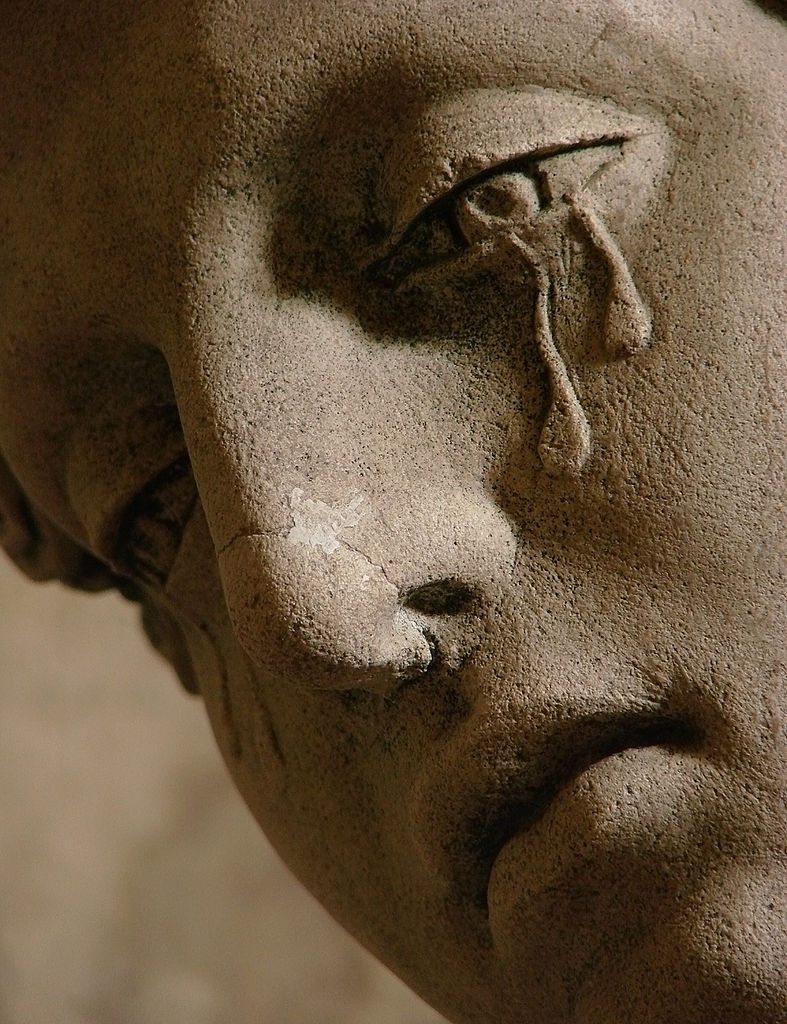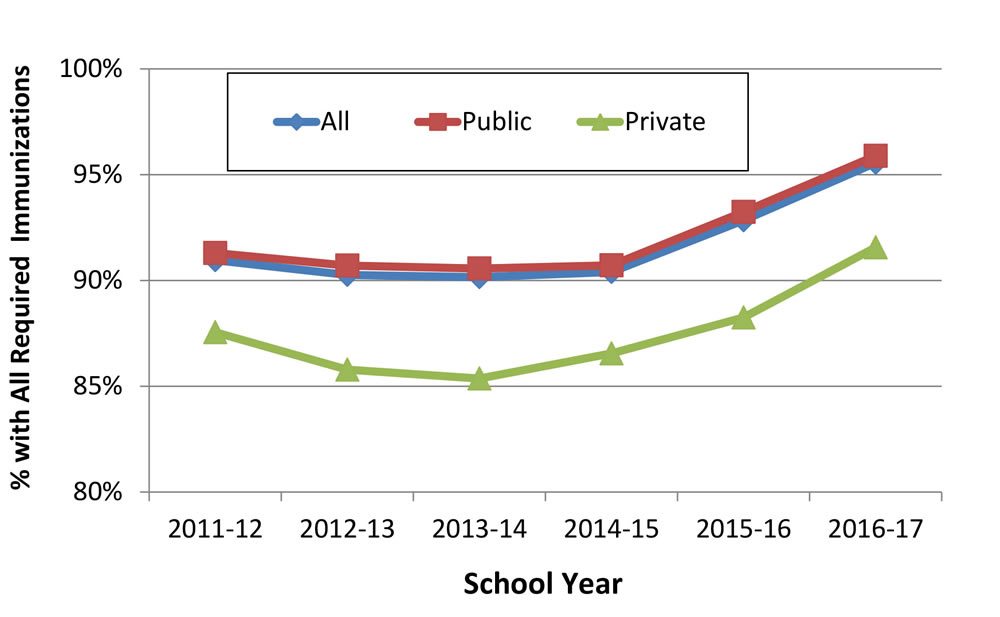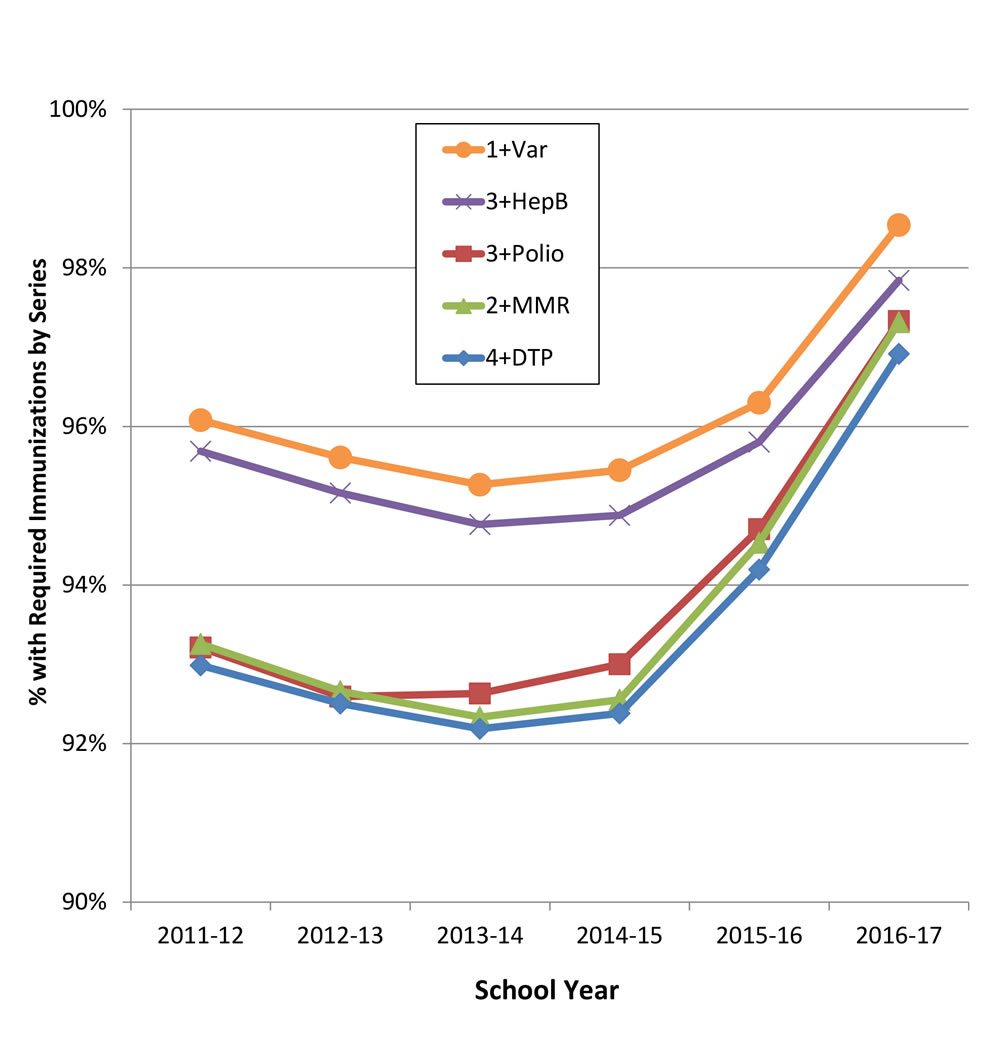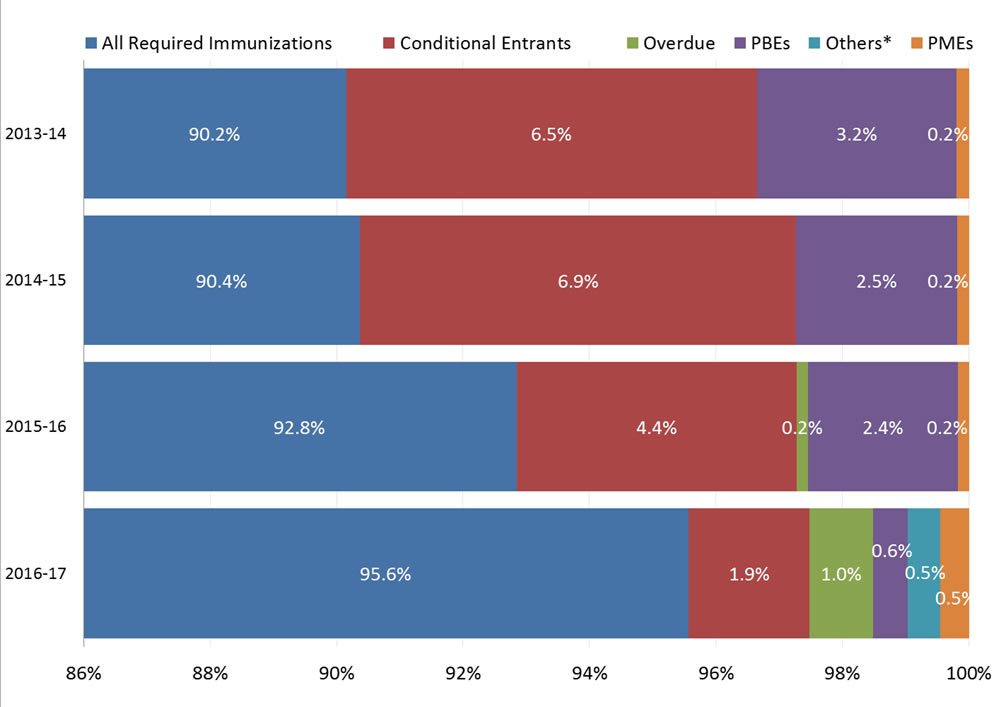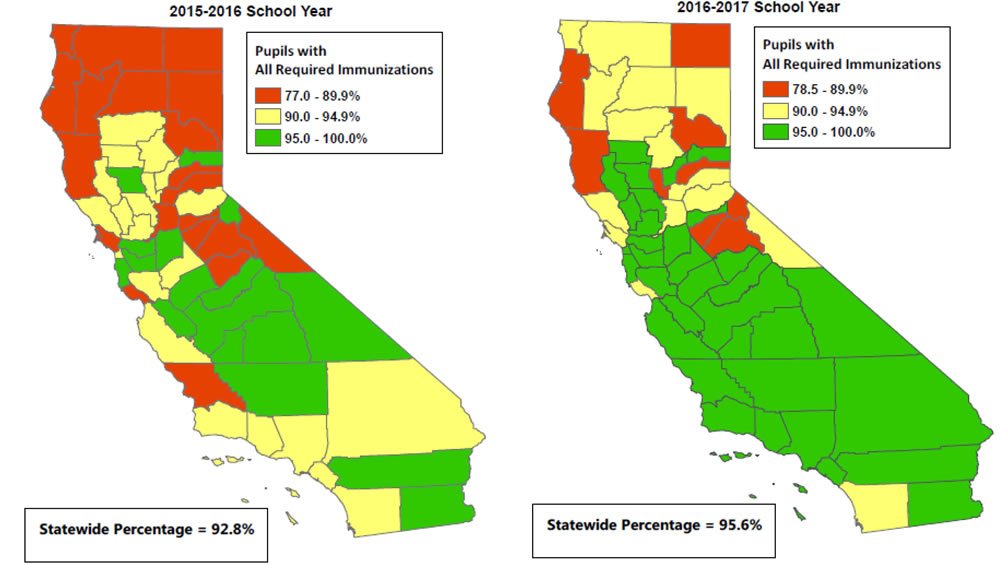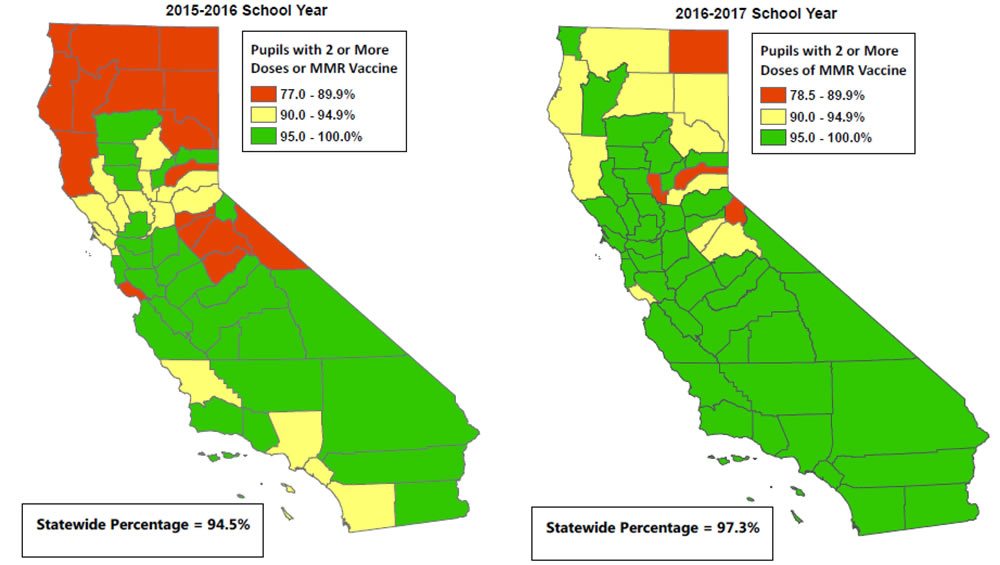[Editor’s note: This is a special bonus post. Dr. Gorski will have another post tomorrow.]
The Disneyland measles outbreak began over the Christmas holidays of 2014 and continued for several months into 2015, ultimately spanning eight states and two additional countries (Canada and Mexico). It also represented a seismic shift in the battle to contain the malign influence of the antivaccine movement in that the outbreak centered at the Magic Kingdom made it possible for California legislators to do something that would definitely not have been possible before the outbreak: Pass a law outlawing “personal belief exemptions” (a.k.a. nonmedical exemptions) to school vaccine requirements. Indeed, given that, prior to the outbreak, only two states (Mississippi and West Virginia, not-coincidentally also two states with very high vaccination rates) allowed only medical exemptions and the other 48 states allowed some combination of religious or personal belief exemptions (PBEs, or, as I like to call them, “I don’t wanna” exemptions), California was the last state I would have imagined passing a law to become like Mississippi or West Virginia. Happily, I was in error. Co-sponsored by Senators Richard Pan and Ben Allen, SB 277 was approved by the California legislature in June 2015 and signed into law by Governor Jerry Brown on June 30, 2015. The new law took full effect in the 2016-2017 school year; i.e., this school year.
The bill (and later law) itself mobilized the antivaccine movement in a way I don’t recall ever having seen it mobilized before. Indeed, there’s a reason why Andrew Wakefield and Del Bigtree bookended their antivaccine propaganda film VAXXED with reports of the Disneyland measles outbreak. It was such a major event in their world view and, given that California is the most populous state in the union, looked to be a profound threat to what they call “freedom” and “parental choice” (conveniently leaving out the rights of the child). Indeed, one could argue that, without SB 277, there very well might not have been a VAXXED, which has been unfortunately influential.
Not suprisingly, SB 277 was a topic of extensive blogging here all through the battle to pass it in 2015 and beyond, when I described how antivaccine-sympathetic pediatricians and other quacks were advertising medical exemptions to school vaccine requirements (which are, of course, still allowed—have to be allowed) as basically being for sale.
When last I looked at the topic a little more than a year ago, preliminary data were suggesting that SB 277 was beginning to have its intended effect. PBEs were declining and vaccine uptake was increasing, both good things. Yesterday, it was pointed out to me that the California Department of Public Health has published the most recent vaccine uptake rates for kindergarten for 2016-2017. The news is good. Vaccinate California provided the “money shot” graph:
What happened when California passed a law to eliminate Personal Belief Exemptions to vaccines? This! CA DPH released analysis just now. pic.twitter.com/OFigphuhIG
— Vaccinate California (@VaccinateCal) April 12, 2017
Notice the trends. PBEs had been increasing inexorably beginning around 1996, with few blips in the upward trend, increasing to nearly four-fold over the course of approximately 18 years. Those of you who haven’t been following vaccine issues (or this blog) for very long might ask: What was AB 2109? Basically, it was the precursor to SB 277. A few years ago, alarmed at the steady upward march of PBE rates, the California legislature passed AB 2109, a law that required parents seeking PBEs to undergo counseling by a pediatrician, advanced practice nurse, or other enumerated health care provider over the risks of foregoing vaccines. The resistance to AB 2109 was almost as fierce as the resistance to SB 277, even though it was a much less stringent law. Indeed, AB 2109 first showed me that Rob Schneider was antivaccine, because that’s when he came out in a big way. Unfortunately, Governor Brown eliminated most of the bill’s impact by adding a signing statement instructing the California Department of Public Health to make an exception for religious exemptions, not requiring parents seeking them to undergo counseling. It was almost certainly an illegal instruction, given that it directly contradicted the language of the law as passed. Unfortunately, the CDPH did not ignore the signing statement, as it should have, and follow the clear language of the actual law.
Even so, as you can see from the graph, for the first time in nearly 20 years, there was a significant dip in the rate of PBEs. This observation is consistent with what we’ve seen here in Michigan after the Michigan Department of Health and Human Services imposed a regulation that was very much like AB 2109, only more stringent in that it isn’t just any doctor in Michigan who can provide the required counseling to parents seeking PBEs. No, here in Michigan, the MDHHS requires that parents actually visit a state or county health department office for standardized counseling. And it works, even better than AB 2109 did in California. Unfortunately, antivaxers in my state have successfully lobbied the legislature to have a bill introduced that would not only overturn the rule requiring counseling but would prevent health officers in our state from barring unvaccinated children from school in the event of an outbreak. Truly, the stupidity of our legislature astounds even me sometimes, as the most recent bill was not the first attempt.
That dip after AB 2109, though, is nothing compared to the dramatic decline in PBEs among kindergarteners. Basically, in a bit more than one year, PBEs fell to levels not seen since the early 1990s. Yes, there was an uptick in medical exemptions, no doubt due to the machinations of Dr. Bob Sears and all the other antivaccine and antivaccine-sympathetic pediatricians and practitioners who saw a chance to profit in a way that aligns with their antivaccine ideology, but that increase is overwhelmed by the rapid decline in PBEs. This is a very good thing indeed. It’s hard not to conclude from these data that eliminating PBEs works—and works very well.
If that doesn’t convince you, check out this graph from the report itself. It shows that the percentage of kindergarteners with all their required vaccines climbed from 90.2% in the 2013-2014 school year to 95.6% in the 2016-2017 school year:
Perusing the data in the report a bit more, I see that the good news just keeps on coming. For instance, here’s another way of showing that the percentage of children with all their required vaccines is increasing not just overall, but for individual vaccines:
And:
Of course, overall statewide vaccine uptake is important, but arguably what is even more important are the areas with the lowest vaccine uptake. The reason, of course, is that these areas provide the raw material for outbreaks of vaccine-preventable diseases through degradation of herd immunity to the point where outbreaks become possible. That’s why these maps of county-wide vaccine uptake should be music to the ears of pro-science, pro-vaccine advocates. For instance, here are maps indicating total vaccine uptake (i.e., the percentage of kindergarteners who had all the required vaccines), with dramatic increases in the percentage who’ve had all vaccines and decreases in the numbers of students with PBEs. Basically, this graph, as the first one does, suggests that both AB 2109 and now SB 277 worked:
And here’s a map indicating the percentage of kindergarteners with two or more doses of MMR:
Notice how, in both maps, multiple counties have increased their vaccine uptake out of the “red zone,” which represents levels of vaccine uptake where herd immunity is likely to be degraded. Granted, most of the counties that “flipped” from red or yellow to yellow or green are counties that aren’t very populous, meaning that what we could be seeing is, at least in part, due to low numbers. It will take data from subsequent years to confirm whether this trend is durable or not. However, I’d be willing to bet that it is. We already know that making PBEs more difficult to obtain increases vaccine uptake; so this increase in vaccine uptake in California is plausible. It’s also welcome.
Per the report:
Of 562,924 kindergarteners whose schools reported their status, 537,991 (95.6%) had received all required immunizations, an increase from the previous school year of 2.8 percentage points (Table 1) and an increase over two school years of 5.2 percentage points (Figures 1, 6). Compared to the 2015-2016 school year, the percentage of students with all required immunizations increased in 50 (86%) of 58 counties (Table 5). For counties reporting at least 25 students, the highest rates were reported in Tulare (98.5%) and San Benito (98.1%) Counties (Tables 3-5). In 2016-2017, 9 (16%) of 58 counties in California have rates of kindergarteners with all required vaccines that are below 90%, compared to 20 (34%) counties in 2015-2016 (Tables 4 and 5, Figure 9).
As in past years, a higher proportion of students in public compared to private schools were reported as having had all required immunizations (95.9% vs. 91.6%; difference of 4.3 percentage points) (Table 1, Figures 7 and 8). However, this gap is smaller in 2016-2017 than it was in 2015-2016 (93.2% vs. 88.2%; difference of 5.0 percentage points), as the one-year increase by 2.7 percentage points in public schools was not as large as the increase by 3.4 percentage points in private schools.
And:
When comparing the 2016-2017 school year to 2015-2016, the proportion of students reported to enter kindergarten in California after receiving all required immunizations increased by 2.8 percentage points to 95.6%, following an increase by 2.4 percentage points between the 2014-2015 and 2015-2016 school years. The 2016-2017 rate of 95.6% is the highest reported to CDPH since varicella vaccine became the most recent addition to the immunizations required for kindergarteners, which began in the 2001-2002 school year.
The CDPH report contains a wealth of information on vaccine uptake, PBEs, and permanent medical exemptions (PMEs). As I documented since the passage of SB 277, antivaccine activists are doing their damnedest to abuse PMEs. For instance, I note an interesting observation in Marin County, PMEs increased from 0.2% in 2015-2016 school year to 2.1% in the 2016-2017 school year, whopping ten-fold increase. In Orange County, another hotbed of antivaccine activity, PMEs increased from 0.2% to 0.8%, a four-fold increase. Interestingly, by comparison in San Francisco County the PME rate only increased from 0.2% to 0.5%. By way of comparison, in Los Angeles County PMEs increased from 0.1% to 0.4%. To be fair, some of this increase could be due to parents whose children need a genuine medical exemption but instead just took a PBE before because it was easier, but it’s also likely that the majority of this increase is due to abuse, in which unscrupulous physicians basically sell medical exemptions based on dubious indications. We already know this started happening not long after SB 277 passed; so it is not surprising that PMEs increased as much as they did in one year. Again, data from future years will determine at what level this increase levels out.
In an ideal world, there would be no PBEs, no exemptions to school vaccine mandates based on anything other than medical indications. Of course, this is not an ideal world. Fortunately, measures that make PBEs difficult to obtain, such as AB 2109 in California and my state’s policy that requires parents who wish to obtain a PBE to visit a state or county health office for counseling on the risks of not vaccinating, also work to increase vaccine uptake. They don’t work as well as eliminating all nonmedical exemptions to school vaccine requirements, but they work and thus are reasonable alternatives to banning nonmedical exemptions in states where it is just politically impossible to do something as radical as SB 277.
Unfortunately, as my own state of Michigan and the state of Texas show, there will be pushback against such efforts. Even worse, somehow over the last several years antivaccine beliefs have been embraced by a segment of the right that lumps antivaccine beliefs as part of “freedom” and “parental rights,” resulting in a dangerous politicization of what was once a bipartisan issue. I fear that California might be the last state to take a step like SB 277 for the foreseeable future. However, all is not lost. Many states are looking into tightening up the requirements for nonmedical exemptions, which is almost as good. From a scientific viewpoint, both work, but eliminating nonmedical exemptions works better than simply making PBEs more difficult to obtain. Given the current political situation, the best that can likely be expected is for some states to tighten up their PBE requirements, and we should support and encourage such efforts wherever they occur. As we say in surgery, “better”—or, even worse, “perfect”—is often the enemy of good.

